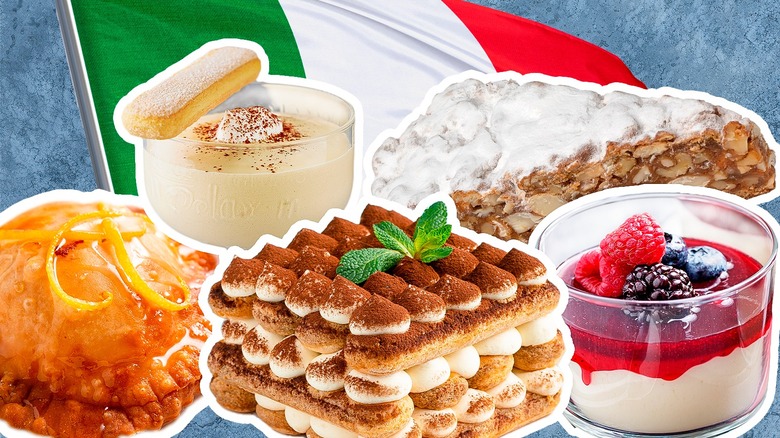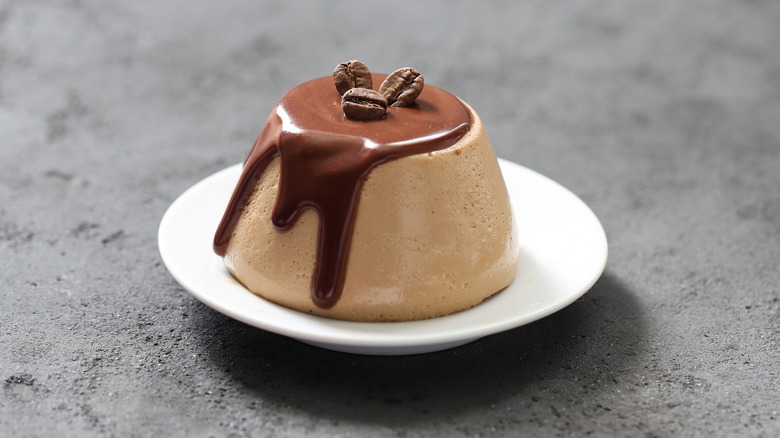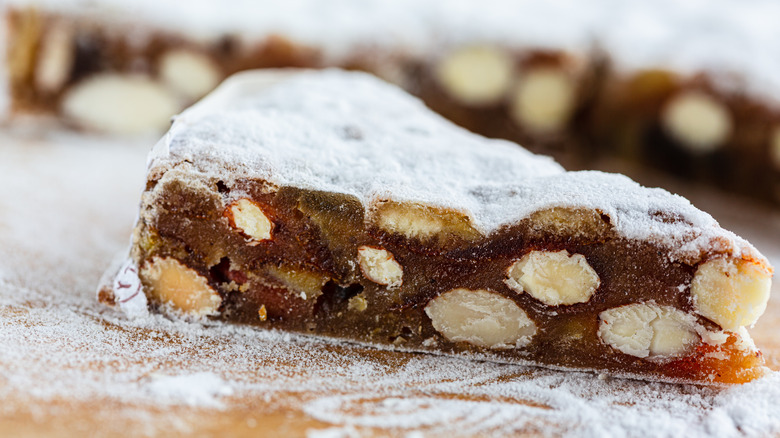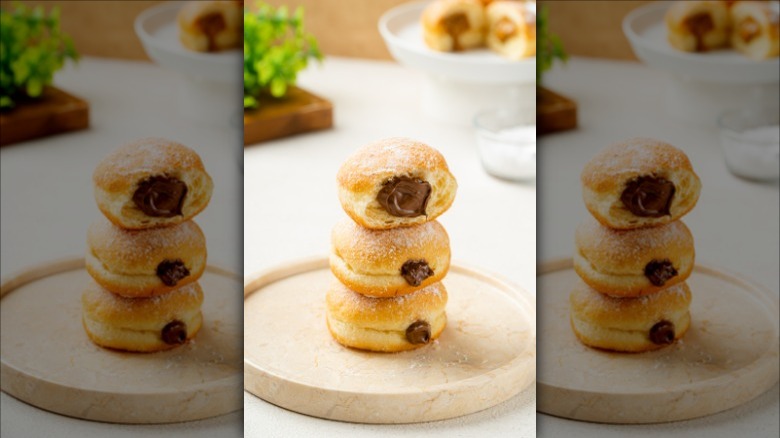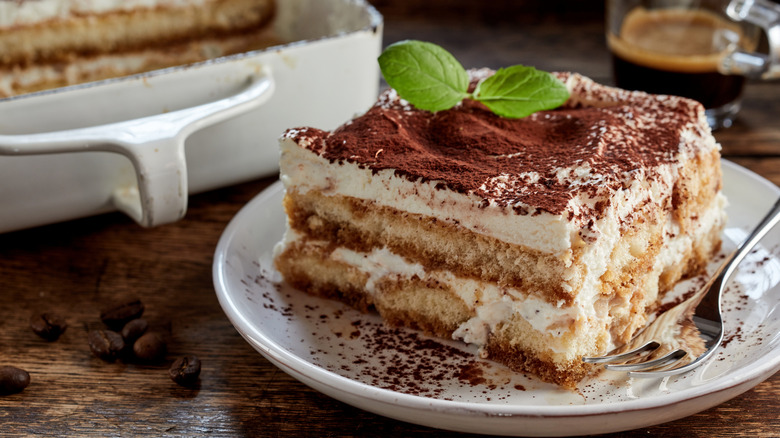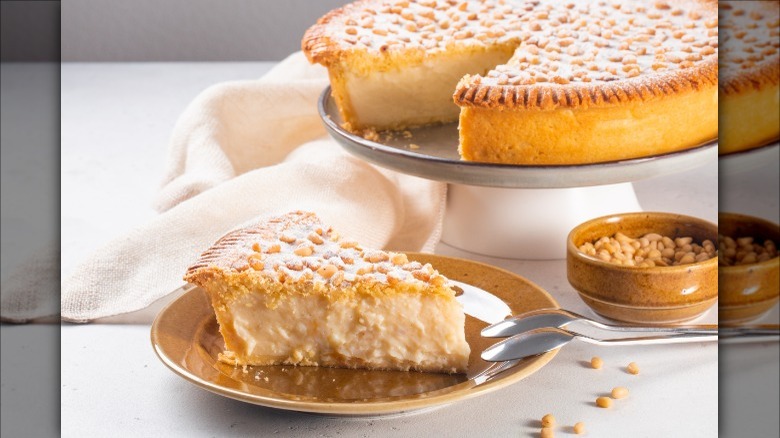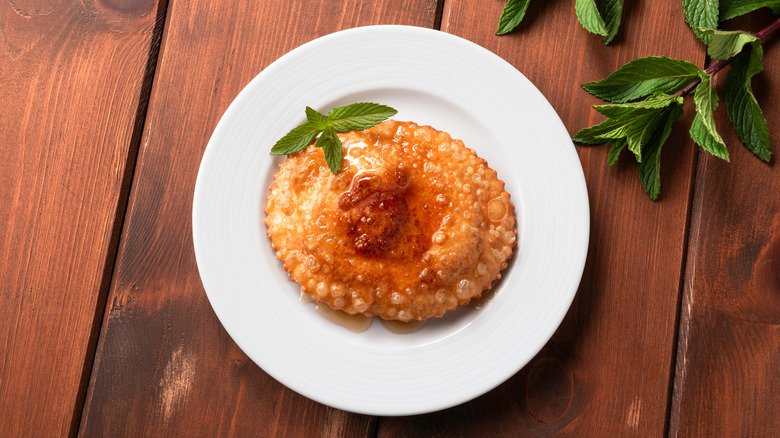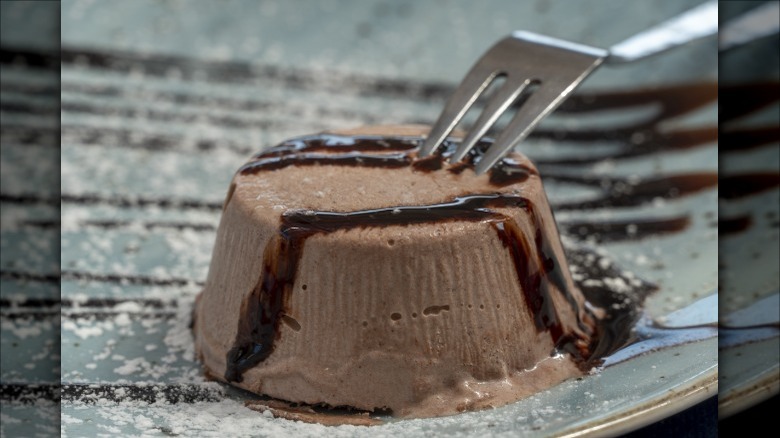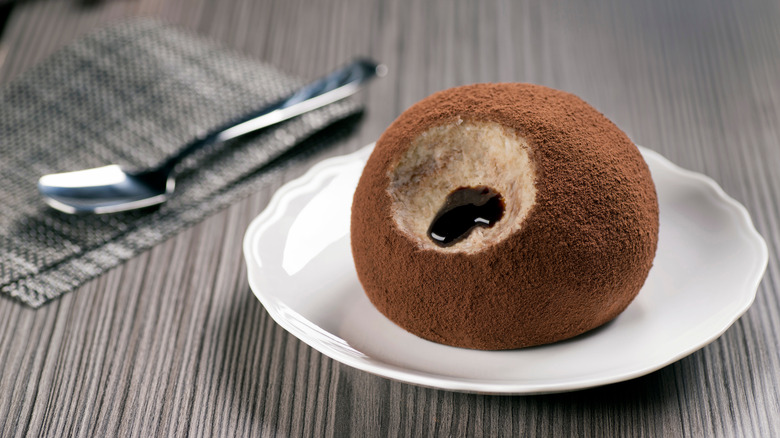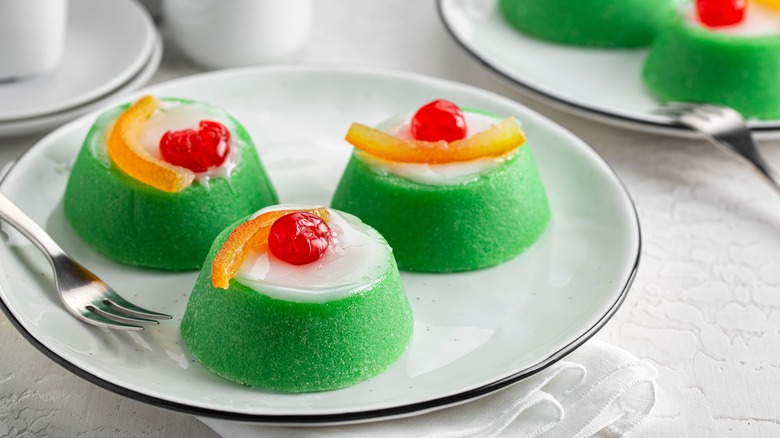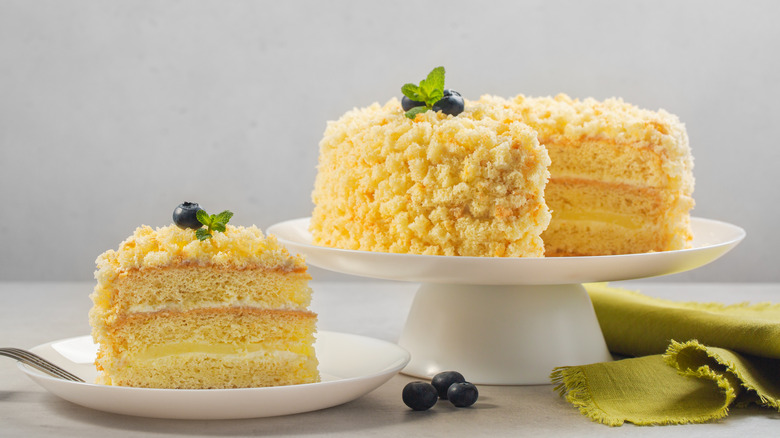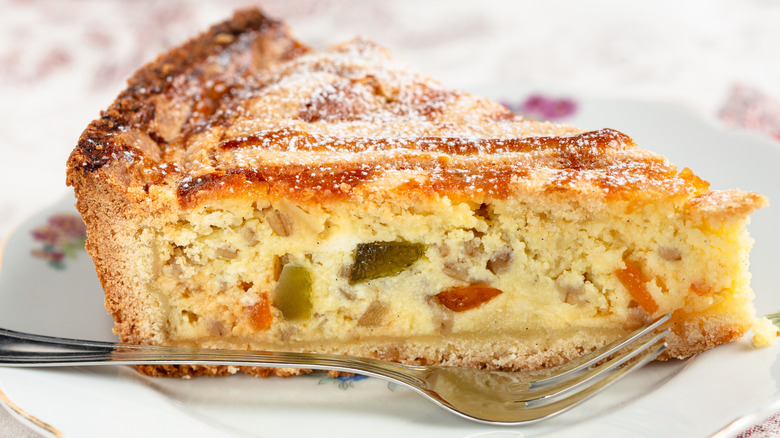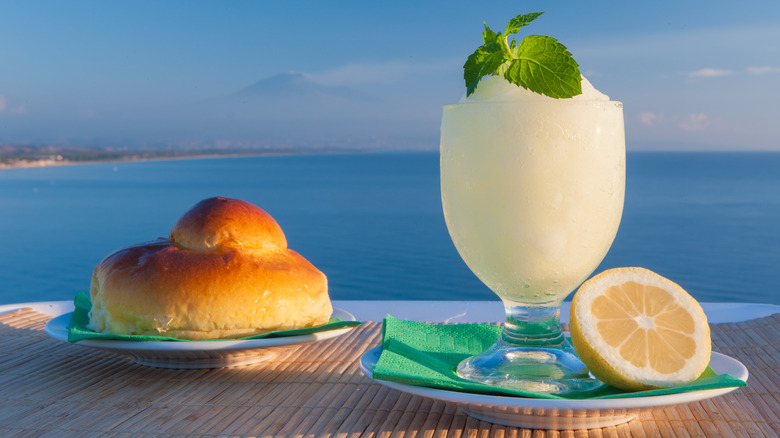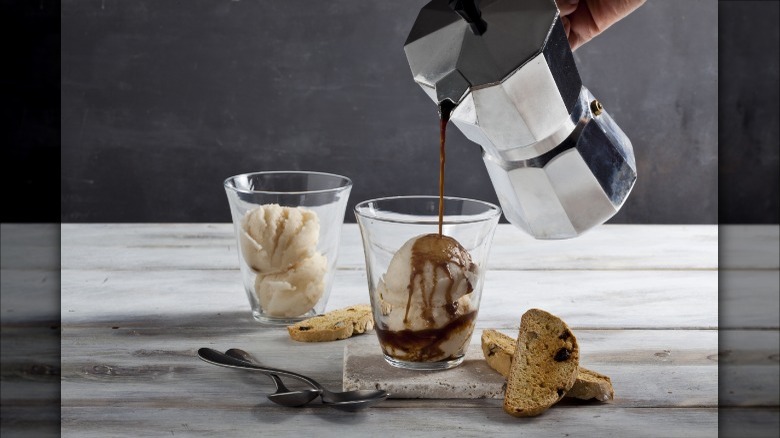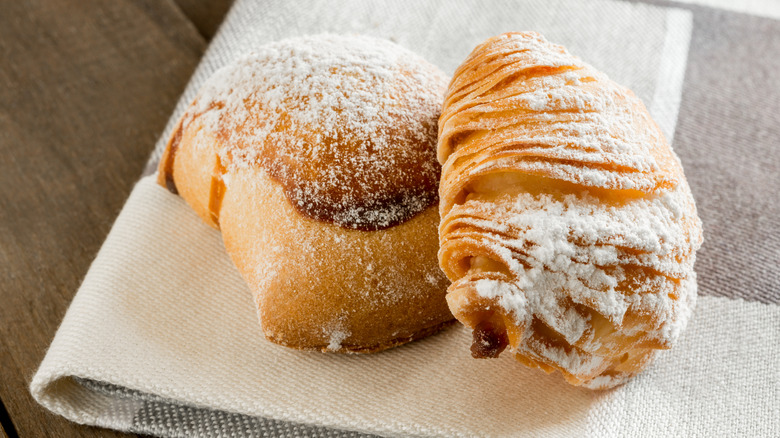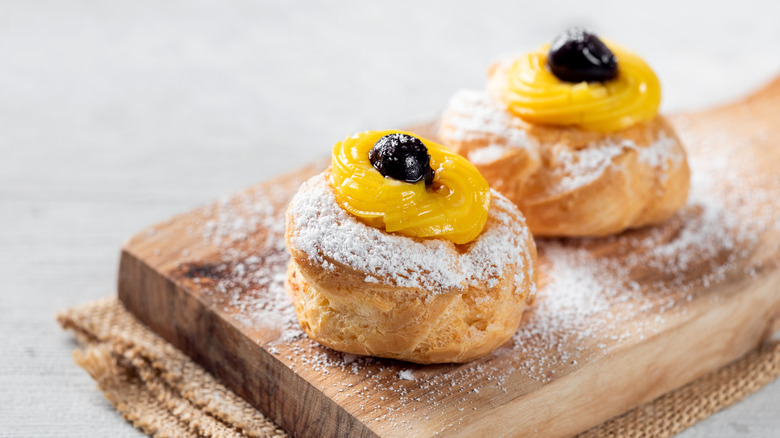17 Italian Desserts To Get To Know
Italy offers a wide variety of cuisine, from pizza, pasta, and bread to risotto, cheese, and dessert. Whether you are dining at an upper-scale restaurant, visiting one of the many Italian bakeries in the U.S., or having fun with recipes at home, Italian food is a delicious option to include in your culinary rotation. Even though there are plenty of things to know about Italian cuisine, we're here to share the sweeter side of Italy. While you may be familiar with desserts like tiramisù, cannoli, or gelato, there are several desserts native to Italy that deserve recognition.
Desserts tend to fall into categories — cake, pie, donuts, ice cream, pastries — but with Italian desserts, each has its own twist that separates it from the sweets known in the U.S. or other countries. So if you're still looking for your fave brownie or pie, Italy likely has its own version. With classic flavor combinations like coffee and cream, hazelnut and chocolate, or fruit-filled recipes, there are plenty of Italian desserts worth trying and learning about.
1. Panna cotta
Originating from Piedmont, panna cotta is both a traditional Italian pudding and a widely known dessert. A classic panna cotta, translated literally as "cooked cream", calls for — you guessed it, cream — and sugar. While different flavors have been incorporated into the recipe, it must have cream, sugar, and some sort of gelatin to give it its form. If you've eaten it before, you know what makes a panna cotta is its jiggly, stable, pudding texture. No matter what flavoring is added, be it coffee, lavender, fruit, almond, panna cotta is almost always served with a warm sauce using caramel, cream, berries, or chocolate. This dessert works best with whole cream, but for a lighter version of the dessert, you can opt for half-and-half or a little milk to cut through the cream.
Traditionally, a Piedmontese panna cotta is served alone or with Brutti ma buoni, according to Italian-born food writer Anna Del Conte. Yet other variations, like boozy panna cotta made with rum or Marsala wine, are common in other parts of Italy. Then there's savory panna cotta, which can consist of salmon, herbs like rosemary, basil, or mint, or pumpkin.
2. Zabaglione
Quite simply, zabaglione is a creamy, custard dessert infused with booze. Sometimes, this dessert is called zabaione or in English, sabayon. Although its exact origins are unknown, zabaglione is undoubtedly Italian, with one legend dating it back to 16th-century Turin and an early recipe found in a 1662 book by Bartolomeo Stefani, the head chef of the Republic of Venice (per Taste Atlas). Despite not fully knowing where in Italy it's from, zabaglione is a traditional Italian dessert prepared the same everywhere: by whisking together egg yolks and sugar in a bain-marie until a thick, creamy custard forms. It is then flavored with some sort of fortified wine. Typically, the recipe calls for Marsala wine, but you can substitute another Italian dessert wine like Vin Santo or a sweet, bubbly wine like Moscato d'Asti or Brachetto d'Acqui. This custard can be served warm or chilled, accompanied by ladyfingers or fresh fruit. Likewise, zabaglione is versatile enough to be a savory dish with added ingredients like oysters, Parmigiano-Reggiano, and white wines instead of sweeter varieties.
3. Panforte
One of Italy's oldest desserts, panforte's origins date back to Siena in the Middle Ages, with the legend claiming that the dessert was made for religious aristocrats in Tuscany. According to Delicious Italy, It became even more popular during the 14th century when people started to travel along the pilgrim route, Via Francigena, on their way to Tuscany. With the trading of exotic spices and fruits, combined with the long-lasting qualities of panforte — it literally translates to "strong bread" — the dessert became a regular choice for travelers. However, the dessert went beyond the trade routes, landing on the plates of the King of Italy in Siena during 1879; it is said that this is the version of panforte we know today.
Now, panforte is considered a winter dessert, as it is often enjoyed around Christmas. Somewhat reminiscent of a fruit cake, panforte is made by mixing fruits (sometimes candied), nuts, and an array of spices like cinnamon, clove, and coriander, in sugar, honey, and flour to create a cake-like dessert.
4. Bomboloni
While sometimes compared to American jelly-filled donuts, bomboloni (singular, bombolone) are considered a different class of pastry, and an Italian delight. Bomboloni are said to have originated in Tuscany or northern Italy. Still, they are similar. As Italian pastry chef Fabio Mussi tells La Cucina Italiana, the primary difference between bomboloni and donuts is the patience required to make and proof the dough. Chef Mussi explains that bomboloni dough takes about a day and a half to make, and rushing could ruin the soft and fluffy texture bomboloni are known for. Some chefs, like baker Vincenzo Virzì, let their bomboloni dough rise for upwards of eight hours before frying them.
Another difference between a bombolone and a donut is the lack of glaze. While bomboloni are warm, they are rolled in sugar and then cooled completely before a filling, like mascarpone, Nutella, or ricotta, is added. In true Italian fashion, bomboloni pair well with coffee or espresso and can be enjoyed across Italy as well as in American cities rich in Italian cuisine, like New York City.
5. Tiramisù
Despite having its origins in the modern 20th century, tiramisù quickly became a traditional Italian dessert with such popularity that you've likely heard of it and eaten it. But did you know tiramisù didn't even arrive in America until the 1980s? According to The New Yorker, the popular dessert debuted at Le Beccherie, an Italian restaurant run by Ado Campeol, in the early seventies. Supposedly, Ado's wife came up with the dish with Roberto Linguanotto, who was the pastry chef at Le Beccherie, as an uplifting treat while she was pregnant (tiramisù translates literally to "pick-me-up"). While this is still up for debate, the aforementioned recipe was certified as the official tiramisù recipe in 2010. The current owner of Le Beccherie has kept the recipe the same. By 1981, the popular dessert had made its way through Italy and across the ocean to America, where we still love it today.
If you're a beginner to tiramisù, you should know that the dessert has ingredients simple enough to enjoy the dish in a restaurant or to make in your own kitchen. With only six ingredients — sugar, eggs, espresso, mascarpone, cocoa powder, and savoiardi, otherwise known as lady fingers — tiramisù is a classic, delicious Italian dessert that is easy to make.
6. Torta della Nonna
Translated as "Grandmother's cake", Torta della Nonna is a classic Italian dessert that consists of sweet shortcrust pastry and pastry cream. Even though we're not sure whose grandma invented the recipe — some say it originated in Tuscany, some say Florence, and some say Liguria — it's safe to say it tastes as good as a homemade treat made with love by a nonna. Wherever it came from, Torta della Nonna dates back to at least the early 1900s, per Do Eat Better. According to Great Italian Chefs, the recipe's history goes back even farther in time, to the late 1800s when Artusi, the prolific Italian cook, said he encountered a similar dish. Nevertheless, it remains a Tuscan classic, usually served with Sunday lunch.
Essentially a custard tart with notes of lemon and vanilla, Torta della Nonna is prepared like most pastries, with time, effort, and chilling. When the tart is finished and fully cooled, it is topped with pine nuts. The rich, creamy texture combined with the sweet, citric, and nutty flavors give this dessert a simplicity that is reminiscent of grandma's kitchen.
7. Brutti ma buoni
Italy's general word for cookies, biscotti, can be found in several varieties just as American cookies can be. Brutti ma buoni — translated literally as "ugly but good" — is a type of Italian biscotti that are not very aesthetic to the eye, but still delicious, warranting the name. We can't help but think of cookies such as no-bake cookies; they look like something you shouldn't eat, but they are super tasty. Brutti ma buoni; however, are baked until they are both crunchy and chewy. They require only a few basic ingredients for the dough: egg whites, butter, flour, sugar, cinnamon, vanilla extract, and hazelnuts or almonds (depending where you are). In Tuscany, bakers typically use hazelnuts, while the original recipe calls for almonds.
The Italian cookies are said to have originated around 1878 in a small city outside of Milan, in the Lombardy town of Gavirate, by a pastry chef and pastry shop owner, Costantino Veniani (via Taste Atlas). Yet, like many Italian delights, the true origin is debated. According to True Italian, Brutti ma buoni might've hailed from Piedmont, in the town of Borgomanero, part of Novara, Italy. Even though it is said that Costantino recorded how to make the biscuits in a notebook, no one can truly decide if the dessert came from Piedmont or Lombardy.
8. Seada
Sardinia, the second largest island of the Mediterranean, is home to many foods like saffron and malloreddus pasta (Sardinian gnocchi). It's also where the popular dessert dumpling, seada, was born. The dessert adopts the flavors of the island with savory and sweet flavors like pecorino cheese, which pairs well with several foods, lemon zest, and honey. Seadas are just fried semolina dumplings stuffed with a filling of cheese and lemon zest, typically garnished with honey. Unlike the sweeter honey we're used to, seadas are usually topped with chestnut honey, which is somewhat bitter.
During festivities and holiday seasons in Sardinia, seadas are almost always present. Originally, the dessert was common in poorer regions because the simple ingredients were easy to procure. Different variations have come about, with the use of plain flour instead of semolina or orange peel instead of lemon zest. Sometimes, the dish omitted any of the sweeter flavors, so instead of being served as a dessert, it was more of a savory snack or lunch dish. Like most Mediterranean cuisine, seadas are fried in olive oil, but they can be baked for a lighter version of the dessert.
9. Semifreddo
Semifreddo, which means "half-cold", is prepared by gently folding whipped cream into an Italian meringue that can be flavored with fruits, nuts, chocolate, coffee, or Italian custard. As its name suggests, semifreddo is chilled until it's set and then served partially frozen. Some have compared the original version of semifreddo to the French parfait, yet the textures divide the desserts. While the New York Times coins semifreddo as "ice cream's chic Italian cousin", it is much more like a frozen mousse with a base of meringue or zabaglione. The soft, airy meringue gives it a melt-in-your-mouth texture that sets it apart from ice cream.
Possibly one of the first semifreddos in history, zuccotto, is prepared with cognac, maraschino liqueur, and French orange liqueur. According to Chef Vary, it was first made for Caterina de Medici and used various ingredients like fruits, chocolate, ground almonds (which were considered an aphrodisiac — fitting for Caterina, no?), and of course, booze. While several variations exist, semifreddo remains an Italian classic that supposedly beats out both parfait and ice cream.
10. Tartufo
Born out of necessity and ingenuity, tartufo (lit. "truffle") is an Italian dessert that first appeared in 1952 in Pizzo, a seaside town in Calabria, in southern Italy. It all started when a descendant of the King of Italy visited for a wedding, and there weren't molds to shape and serve the gelato dessert. The pastry chef, Don Pippo, quickly improvised so the celebration for the prince wasn't affected. By molding the gelato into balls with his hands, then filling it with sauce and coating the balls in sugar and cocoa, tartufo was born (per Iitaly Calabria). Now, the dessert can be found in gelaterias all over Pizzo.
Traditionally, the dessert is made of a large ball of chocolate and hazelnut gelato, which is filled with a molten chocolate center, and then covered lightly with cocoa powder. Many variations exist since the first recipe, such as limoncello tartufo (lemon sorbet covered in powdered lemon sugar), coffee 'tartufo bianco', and tartufo covered in almonds or pistachios instead of cocoa powder. Whichever kind the gelateria offers, tartufo is a delicious treat that you won't regret ordering.
11. Cassata
One of Sicily's more famous desserts, cassata is a traditional dessert that is prepared by soaking genoise sponge cake in liqueur, then layering sweetened ricotta and fruit preserves before being finished with a marzipan shell and candied fruit. Similar to a cheesecake that uses ricotta, cassata cake is served around Easter and became a prominent aristocratic dish by the 14th century, per Taste Atlas.
Although the history of cassata cake is debated, there are a few theories that have stood the test of time. As Eater suggests, there is undeniably a connection between cassata cake and the invasion of Sicily by the Arabs during the 10th century. It is said they brought certain sugar production techniques to Sicily, and because "cassata" could stem from the Latin word cāseāta (from cāseus, meaning "cheese"), the true origin of the cake hasn't quite been figured out. Still, it is a staple dessert of Sicily that many natives enjoy around Easter. With its delicate, complex preparation, the beautiful cake isn't as easily made at home, but that shouldn't stop you from giving it a taste if you find it in the world.
12. Torta mimosa
Every March 8th, it is Italian custom to serve torta mimosa as a symbol for International Women's Day, or La Festa della Donna. Inspired by the mimosa flower that Italian men would give to women during La Festa della Donna, this traditional mimosa cake is bright, citric, and rather quick to make, per Italian Traditions. Mimosa flowers are considered delicate and beautiful with their yellow hue, but they are also able to withstand harsh environments, making them a wonderful representation of the femininity and strength of women.
Torta mimosa appears much like the yellow flower, with ingredients like pineapple or lemon, custard, and even yellow dye to mimic the flower more. All it takes is two large layers of sponge cake that are wet with either pineapple juice or lemon juice, with a filling of lemon custard. It's finished with icing, crumbled cake bits, and a little bit of sugar. While it tastes wonderful, the true pleasure is in the meaning.
13. Pastiera Napoletana
Another Easter delight, Pastiera Napoletana is one of Naples' most popular cakes, rooted in the city's symbol of the mermaid, Partenope, in Greek mythology. According to La Cucina Italiana, the Neapolitan pastiera's legend goes back to when Partenope had a feast in her honor, where seven symbolic gifts were brought to the siren: flour, wheat cooked in milk, eggs, sugar, spices, orange blossoms, and ricotta cheese. She then combined all the gifts to make pastiera. They go on to suggest another theory that goes back to Constantine and the desserts given during the baptism on Easter night. Then there are the nuns of the convent of San Gregorio Armeno, who were known to be experts in making pastries and often gave them to noble families.
While even the city of Naples can't decide on the origin of the Neapolitan pastiera, the traditional recipe remains pretty exact. The shortcrust pastry is meant to be crunchy with a soft interior of ricotta, eggs, candied fruit, and wheat that has been boiled in milk. The preparation is very complex and time-consuming, and tradition states that the dessert should be made on the Thursday before Easter and served on Easter day to allow for all the flavors to properly mingle.
14. Granita
At first glance, granita seems to resemble neither ice cream nor gelato, but a sno-cone. In fact, the first granitas were made from the snow of Mount Etna that was collected by "nivaroli" during the Middle Ages, according to Visit Italy. Then, it was referred to as "rattata" or "grattata", which translated as "grainy". A sort of icy sorbet was made by mixing the snow with fruit syrups or lemon juice. The grainy bits of snow were eventually substituted for water and blended with sugar and fruit flavors to create the granita known today. You'll typically see granita with two different names: Palermitan granita and Sicilian granita, because the dessert is said to have come from Palermo, Sicily.
Some common granita flavors include lemon, almond, pistachio, coffee (are you even surprised?), peach, mulberry, and strawberry. One of the more popular ways to enjoy granita is with brioche bread. Despite sounding like an unusual pairing, the sweetness of the bread complements the smooth, fruity granita.
15. Affogato
This Italian specialty combines bitter espresso and coffee flavors with the sweetness of ice cream in a dish that literally means "drowned". The origins of affogato are hazy, with some saying the dessert came about in the 1950s when ice cream was streamlined and others saying it emerged much earlier. According to Porte, affogatos were possibly made during experimentation by a Piedmontese friar, Angelico, during the 17th century, when he decided to mix together ice cream with a sort of Frangelico liqueur or espresso. As it became more popular in Italy and other parts of Europe, it made it to America as the frappuccino, which was created by George Howell in 1992 as an ode to affogato.
Now, affogatos usually consist of an ice cream flavor like vanilla, pistachio, or hazelnut and call for the ice cream to be doused in a double shot of espresso. Of course, there are always variations on the classics, and sometimes affogatos use rum, whiskey, or strong coffee liqueur flavors instead of espresso.
16. Sfogliatelle
Originally, the Italian pastries, sfogliatelle (pronounced like "sfoh-lee-ya-tell"; the 'g' is silent, but the 's' is not), are said to have come from Naples, and are considered one of the most popular foods in Campania. However, some believe the pastry to have been first made by the nuns of the Santa Rosa monastery on the Amalfi Coast in the 1700s, according to Taste Atlas. Famous for letting their pastries loose into the world, the nuns supposedly gave their version of sfogliatelle to a Neopolitan chef who started making them on his own.
Sometimes called a lobster tail pastry, the dessert is made of several delicate, thin layers of pastry shaped like a clam shell or lobster tail, and filled with sweetened ricotta and candied orange peel. This traditional version is also known as sfogliatella riccia, which involves adding cinnamon to the filling. Sfogliatella frolla, another variation of the pastry, has the same filling, but is more of a round shape made with crumbly, shortcrust pastry.
17. Zeppole
If bomboloni are the jelly-filled donuts of Italy, zeppole are the cronuts. Although bombolone aren't considered donuts, zeppole come pretty close to the breakfast pastry Americans are familiar with. Instead of being filled like bomboloni, zeppole are more like fritters that are twisted and deep-fried, creating a kind of pastry "nest" for assorted toppings like cream, ricotta, honey, zabaglione, or chocolate. But others say a traditional zeppola does have a filling of rich cream and sour cherry syrup.
Seeing as the Neopolitan gastronome Ippolito Cavalcanti recorded the recipe for zeppole in 1837, the origins are associated primarily with Naples (via Visit Naples). Yet it has been said zeppole were seen even earlier, around the 16th century, at the convent of Santa Patrizia in Naples, according to Fine Dining Lovers. In any case, the zeppola has been linked to the Feast of St. Joseph and Father's Day (which Italy celebrates on March 19) ever since Pasquale Pintauro baked and served them out of a cart for the celebration in Naples during the 19th century.
